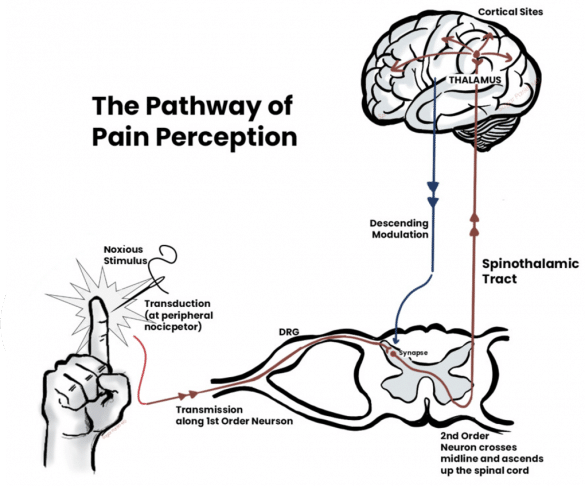As a close Pharma and Biotech partner, ANS Biotech commits itself to providing cost-effective preclinical pharmacology services and to generating robust outcomes in keeping with targeted deadlines.
The acetic acid test is a tonic pain test based on the use of a chemical stimulus. Intraperitoneal injection of 0.6% acetic acid solution in rats triggers abdominal contractions as a manifestation of pain. The number of writhings is recorded from the 5th to the 15th minute after injection of the solution.
This assay is widely used to evaluate the potential antinociceptive activity of compounds in visceral pain.
The formalin test is a tonic pain test based on the use of a chemical stimulus. Subcutaneous injection of formalin into the right hindpaw produces a biphasic response of increasing and decreasing pain intensity for about 30 minutes after the injection. The initial phase of the response (early phase), likely caused by a burst of activity from C fibers, begins immediately after the formalin injection and lasts about 5 minutes. The second phase of the response (late phase) starts 15 to 20 minutes after the formalin injection and lasts 20 to 40 minutes. This phase involves a central sensitization during which inflammatory phenomena occur. Classically, scoring of the cumulative time spent licking the injected hindpaw or scoring of the behavior during both phases is used to quantify formalin-induced nociception. This assay is widely used to determine the potential analgesic effects of compounds for states of persistent pain in which tissue damage occurs.
The hot plate test is an acute pain test based on the use of a thermal stimulus. The animal is placed in an open-ended space with a floor consisting of a metallic plate precisely heated by a thermode. The plate, heated at a constant temperature (52°C or 56°C), produces two behavioral components that can be measured in terms of their reaction times (with a cut-off time set at 30 seconds to prevent tissue damages), namely paw licking and jumping. Both are stereotyped behaviors in rodents (rats and mice) and are considered to be supraspinally integrated responses. This assay is widely and reliably used for revealing the potency of new analgesics.
The tail flick test is an acute pain test based on the use of a thermal stimulus. Radiant heat is applied to the tail; when the animal feels discomfort, it reacts by a sudden tail movement (tail flick) that automatically stops the stimulation and an animal reaction time or nociceptive reaction latency (period from the beginning of the stimulation until detection of the response of the animal) is recorded. A cut-off is fixed at 10 sec to prevent tissue damage. This test has proved particularly sensitive for studying the analgesic properties of pharmacological substances.
In animals, thermal hyperalgesia is measured by latency of paw withdrawal from the point of heat using the plantar analgesimeter. In this test, a thermal stimulus is applied to the plantar surface of both hindpaws of the rat, and the latency of reaction is recorded.
Thermal hyperalgesia is assessed by means of a thermal stimulus using the plantar analgesimeter. In this test, a radiant heat will be applied to the plantar surface of both hindpaws and the latency of paw withdrawal from the point of heat is automatically recorded. This test is typically used in animals with one hindpaw inflamed by injection or injury, and one normal hindpaw, to evaluate drugs for analgesic action or to characterize antihyperalgesic effects.
Static mechanical hyperalgesia is assessed using the Paw Pressure test or Randall & Selitto test. This test requires the application of an increasing pressure on the hindpaws between a flat surface and a blunt pointer. The apparatus exerts a steadily increasing force and reaction threshold is determined as the pressure (g) required to elicit paw withdrawal and/or vocalization. This test is typically used with animals with one hindpaw inflamed by injection or injury by ligation, and one normal hindpaw, to evaluate drugs for analgesic action.
Tactile allodynia is assessed using the electronic Von Frey test. This test requires the application of an increasing pressure onto the plantar aspect of the hindpaws. The apparatus exerts a steadily increasing force and reaction thresholds are determined as the pressure required to elicit paw withdrawal. Three consecutive measures are done for both intact and injured hindpaws.
Pain is a necessary protective reaction that alerts the body to the presence of actual or potential tissue damage such as a sprained ankle, burn or a paper cut, then resolving while the healing process is underway. Under normal conditions, stimuli approaching or exceeding harmful intensity are transmitted from different locations in the body to the brain that, in turn, interprets this information as a sharp and severe sensation of pain.
ANS Biotech offers standard pain tests utilizing chemical, thermal and mechanical stimuli. These assays are widely and reliably used to reveal the efficacy of new analgesics.

